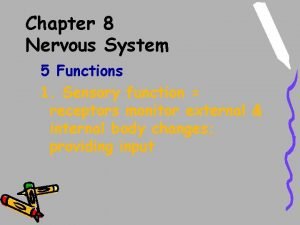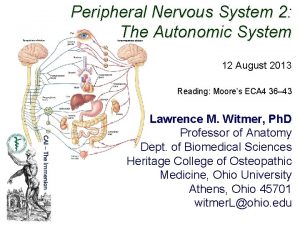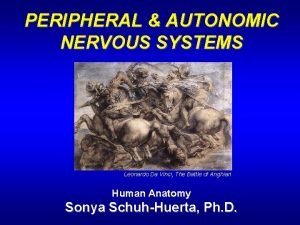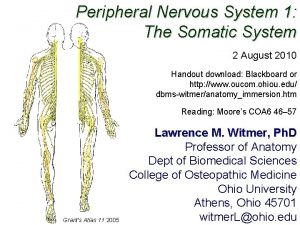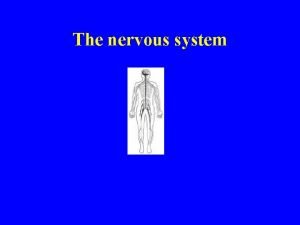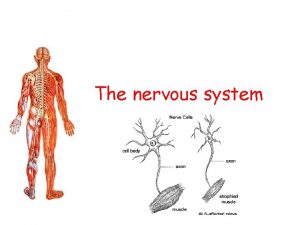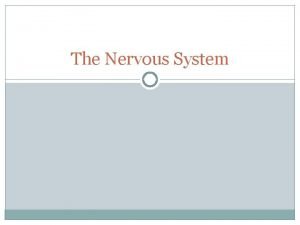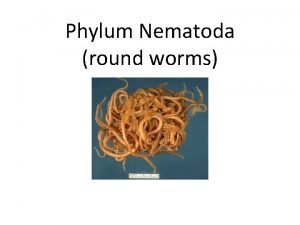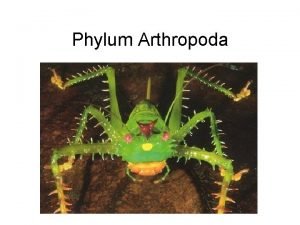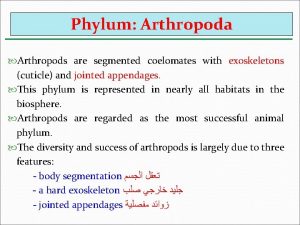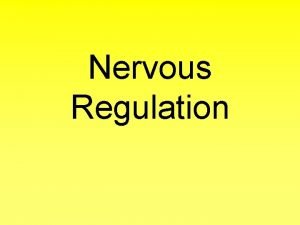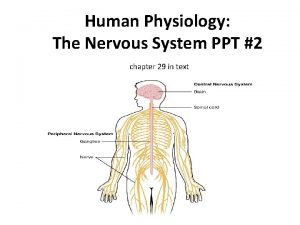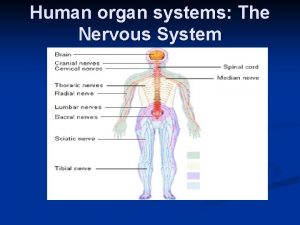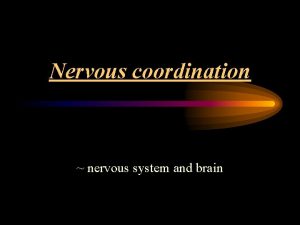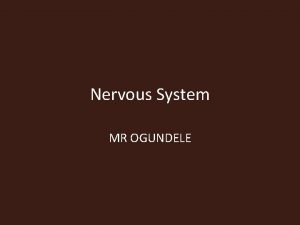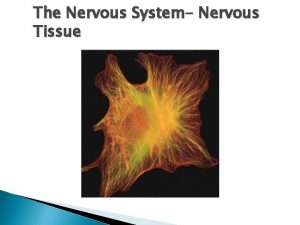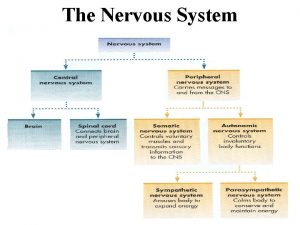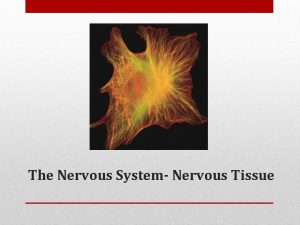THE NERVOUS SYSTEM FUNCTIONS AND ORGANIZATION FUNCTIONS collection
















































- Slides: 48


THE NERVOUS SYSTEM FUNCTIONS AND ORGANIZATION

FUNCTIONS • collection of sensory input • integration • motor output The function of the nervous system of all animals is to detect changes in the: External or Internal environments. So, it bring about appropriate responses in Muscles, Organs and Glands.

ORGANIZATION • • STRUCTURAL CNS PNS FUNCTIONAL sensory division (Afferent) motor division (Efferent) – autonomic – somatic

Neurons The basic structural (anatomical) , functional and embryological unit of the nervous system is the nerve cell or neurone. Prof. human Saeed Makarem The nervous system is estimated to contain about 1010.

• The functions of the neuron are to receive and integrate incoming information from sensory receptors or other neurons and to transmit information to other neurons or effector organs. • Neuronal structure is highly specialized to fulfill these Prof. Saeed Makarem functions.

Information is passed between neurons at specialized regions called synapses In the synapses the membranes of adjacent cells are in close apposition (contiguity not continuity). Prof. Saeed Makarem

• There is wide diversity in the shape and size of neurons in different parts of the nervous system. • But all share certain common characteristics. • There is a single cell body from which a variable number of branching processes emerge. Prof. Saeed Makarem

Most of these processes are receptive in function. They are known as dendrites. Prof. Saeed Makarem

The dendrites possess synaptic specializations, sometimes many thousands of them, through which they receive information from other neurons with which they make contact. Prof. Saeed Makarem

In sensory neurons, the dendrites may be specialized to detect changes in the external or internal environment. Olfactory receptor neurons Prof. Saeed Makarem

Prof. Saeed Makarem • One of the processes leaving the cell body is called the axon which carries information away from the cell body. • Axons are highly variable in length and may divide into several branches or collaterals through which information can be distributed to a number of different destinations simultaneously. • At the end of the axon, specializations called terminal buttons occur. • Here information is transferred to the dendrites of other neurones.

Prof. Saeed Makarem • Transmission of information between neurons almost always occurs by chemical rather than electrical means. • Action potential causes release of specific chemical that are stored in synaptic vesicles in the presynaptic ending. • These chemicals are known as neurotransmitters and diffuse across the narrow gap between pre- and postsynaptic membranes to bind to receptors on the postsynaptic cell, inducing changes in the membrane potential.

Neuroglia • Neuroglia, or glia cells constitute the other major cellular component of the nervous system. • It is a specialized connective tissue for the nervous system. • Unlike neurones, neuroglia do not have a direct role in information processing but they are essential for the normal functioning of nerve cells. Prof. Saeed Makarem

Three main types of neuroglial cell are recognized: 1. Oligodendrocytes (oligodendroglia) they form the myelin sheath that surrounds many neuronal axons, which increase the rate of conduction. Prof. Saeed Makarem

2. Microglia have a phagocytic role in response to nervous system damage. Prof. Saeed Makarem

3. Astrocytes are thought to form a selectively permeable barrier between the circulatory system and the neurons of the brain and spinal cord. • This is known as the 'blood-brain barrier' and has a protective function. Prof. Saeed Makarem

Central and peripheral nervous systems

The nervous system is divided into: • 1 - Central nervous system (CNS). • 2 - Peripheral nervous system (PNS). Prof. Saeed Makarem

• The central nervous system consists of the brain and the spinal cord, lying within the protection of the cranium and vertebral column, respectively. • This is the most complex part of the nervous system. • It contains the majority of nerve cell bodies and synaptic connections. Prof. Saeed Makarem

• The peripheral nervous system constitutes the link between the CNS and structures in the periphery of the body. • It receives sensory information from the body. • It sends controlling impulses in response to these information. • The peripheral nervous system consists: • 1 - Cranial nerves • 2 - Spinal nerves. Prof. Saeed Makarem

• Spinal nerves serving the upper or lower limbs form the brachial or lumbar plexus. • Nerve cell bodies that are aggregated within these structures called ganglia. Prof. Saeed Makarem

Autonomic Nervous System

• Neurones that detect changes in, and control the activity of, the viscera are collectively referred to as the autonomic nervous system. • Its components are present in both the central and peripheral nervous systems. Prof. Saeed Makarem

Prof. Saeed Makarem • The autonomic nervous system is divided into two anatomically and functionally distinct parts: • Sympathetic and parasympathetic divisions. • They generally have antagonistic effects on the structures that they innervate. • The autonomic nervous system innervates: • Smooth muscle, • Cardiac muscle, • Secretory glands. • It is an important part of the homeostatic mechanisms that control the internal environment of the body.

Afferent, Efferent and Interneuron • Nerve cells that carry information from peripheral receptors to the CNS are referred to as afferent neurones. • If the information they carry reaches a conscious level they are also called sensory neurons. • Efferent neurones carry impulses away from the CNS • If they innervate skeletal muscle to cause movement they are also referred to as motor neurons. • The vast majority of neurones, however, lies entirely within the CNS and are usually called

REGIONS OF THE BRAIN • Cerebral hemispheres • Diencephalon • Cerebellum • Brain stem

CEREBRAL HEMISPHERES FRONTAL PARIETAL TEMPORAL OCCIPITAL • The largest part of the brain • They have elevations, called gyri • Gyri are separated by depressions called sulci • Each hemisphere is divided into 4 lobes • Lobes are separated by deeper grooves called fissures or sulci.

MAIN SENSORY AREAS OF THE CORTEX olfactory • Somatic sensory area is located in the parietal lobe posterior to the central sulcus • Visual area in the medial surface of the posterior lobe • Auditory sensations are received in the temporal lobe close to the lateral sulcus • Olfactory sensations are received deep inside the temporal lobe

PRIMARY MOTOR AREA OF THE CORTEX • Primary motor area is located in the frontal lobe, anterior to the central sulcus • Body is represented upside down • Axons of these neurons form the pyramidal tract (corticospinal tract)

TISSUE OF THE CEREBRAL HEMISPHERES • • • Basal nuclei • • The outermost layer is the gray matter or cortex Deeper is located the white matter, composed of bundles of nerve fibers, carrying impulses to and from the cortex Corpus callosum is a very large fiber tract connecting the 2 cerebral hemispheres Basal nuclei are made from gray matter and are located deep within the white matter They help the motor cortex in the regulation of voluntary motor activities

DIENCEPHALON The diencephalon is located between the 2 hemispheres and is linked to them and to the brainstem. The major structures of the diencephalon are thalamus, hypothalamus and Epithalamus.

THALAMUS The thalamus is a relay station for sensory impulses passing upward to the sensory cortex.

EPITHALAMUS The epithalamus forms the roof of the 3 rd ventricle. It is made from two parts: the pineal body and the choroid plexus. The choroid plexus produces cerebrospinal fluid. The pineal body is part of the endocrine system.

HYPOTHALAMUS The hypothalamus is an important center for regulation of the autonomic nervous system. It regulates body temperature, water balance and metabolism. It is connected to the pituitary gland, important for the regulation of the endocrine system, and the mammillary bodies, reflex centers involved in olfaction.

THE LIMBIC SYSTEM • • The hypothalamus is an important part of the limbic system. The hypothalamus has centers that regulate : Appetite, Thirst, Sex, Pain, Pleasure

BRAIN STEM The brainstem has three parts: midbrain, Pons and medulla oblongata.

MIDBRAIN The midbrain extends from the mammillary bodies to the Pons. It has 3 parts: cerebral aqueduct, cerebral peduncles and corpora quadrigemina.

MIDBRAIN Corpora quadrigemina are reflex centers involved with vision and hearing. The cerebral aqueduct is a canal connecting the 3 rd and the 4 th ventricle.

MIDBRAIN The cerebral peduncles are two big fiber tracts which carry ascending and descending fibers.

PONS The Pons is a rounded part of the brainstem that contains mainly fiber tracts. The reflex center regulating breathing is also located there.

MEDULLA OBLONGATA Medulla oblongata connects the brain with the spinal cord. It contains many fiber tracts and the centers that regulate heart rate, blood pressure, breathing, swallowing and vomiting.

CEREBELLUM Cerebellum has 2 hemispheres and a convoluted surface. It has an outer cortex of gray matter and an inner region of white matter. It provides precise coordination for body movements and helps maintain equilibrium.

PROTECTION OF THE CNS • • • THE CNS IS PROTECTED BY: Skull & vertebral column (bone) Meninges (membranes) Cerebrospinal fluid (watery cushion) • • • THERE ARE 3 LAYERS OF MENINGES: Dura mater (outer) Arachnoid mater (middle) Pia mater (inner)

MENINGES DURA MATER • • • Double-layered membrane Outermost layer is attached to the inside surface of the skull bones (endostial layer) Internal layer (meningeal layer) covers the surface of the brain and the spinal cord The two layers are fused together, except in 3 places where they form channels (dural sinuses) where venous blood from the brain is collected in some places the inner dural membrane forms folds (falx cerebri) that attaches the brain to the cranial cavity ARACHNOID MATER • • • looks like cobweb has threadlike extensions (arachnoid villi) that attach it to the innermost membrane (pia mater) the arachnoid villi absorb cerebrospinal fluid contains the subarachnoid space filled with cerebrospinal fluid PIA MATER thin, delicate membrane attached to the surface of the brain

BRAIN VENTRICLES • Brain is bathed by the cerebrospinal fluid (CSF) • Inside the brain, there are spaces (ventricles) filled with CSF • There are 4 ventricles Ø 2 lateral ventricles are in the hemispheres Ø 3 rd ventricle in the diencephalon Ø 4 th ventricle between the Pons and the cerebellum Ø Cerebral aqueduct connects the 3 rd to the 4 th ventricle

CEREBROSPINAL FLUID CSF is constantly produced by the choroid plexuses inside each ventricle. Inside the brain, CSF flows from the lateral ventricles in the 3 rd and 4 th ventricle. From the 4 th ventricle, part of the CSF flows down in the central canal of the spinal cord. Most of the CSF drains from the 4 th ventricle in the subarachnoid space around the brain and returns to the dural sinuses through the arachnoid villi.

THANK YOU
 Neuron process
Neuron process Sensory input and motor output
Sensory input and motor output Nerve cell process
Nerve cell process Nervous system and digestive system
Nervous system and digestive system Endocrine system and nervous system
Endocrine system and nervous system Endocrine system vs nervous system
Endocrine system vs nervous system Primary functions of the nervous system
Primary functions of the nervous system 5 functions of the nervous system
5 functions of the nervous system Amino acid-based hormones
Amino acid-based hormones Methods of data organization and presentation
Methods of data organization and presentation Landsat collection 1 vs collection 2
Landsat collection 1 vs collection 2 Documentary collection definition
Documentary collection definition Point by point organization essay
Point by point organization essay The body's speedy electrochemical communication network
The body's speedy electrochemical communication network Section 35-4 the senses
Section 35-4 the senses Comparison of endocrine and nervous system
Comparison of endocrine and nervous system Chapter 15 nervous system diseases and disorders
Chapter 15 nervous system diseases and disorders Exocrine glands are ductless
Exocrine glands are ductless Sympathetic and parasympathetic nervous system difference
Sympathetic and parasympathetic nervous system difference Sympathetic and parasympathetic nervous system difference
Sympathetic and parasympathetic nervous system difference Major division
Major division Central and peripheral nervous system
Central and peripheral nervous system Pns
Pns Graphic organizer nervous system
Graphic organizer nervous system Somatic and autonomic nervous system
Somatic and autonomic nervous system Process organization in computer organization
Process organization in computer organization Chemical messengers of the nervous system
Chemical messengers of the nervous system Annelida and nematoda
Annelida and nematoda The nervous system is made up of
The nervous system is made up of Nervous system learning objectives
Nervous system learning objectives Componentes componentes
Componentes componentes What is stimuli in nervous system
What is stimuli in nervous system Neuron bundle
Neuron bundle Craniosacral region
Craniosacral region Autonomic nervous system def
Autonomic nervous system def Nerve plexus
Nerve plexus Somatic nervous system (sns)
Somatic nervous system (sns) The nervous system brain scienstructable
The nervous system brain scienstructable Autonomic nervous system muscles
Autonomic nervous system muscles Nematoda
Nematoda Tagmata adalah
Tagmata adalah Jointed foot phylum
Jointed foot phylum Nervous system of arthropods
Nervous system of arthropods Parasympathatic
Parasympathatic Nervous system of coelenterata
Nervous system of coelenterata Autonomic nervous system consists of
Autonomic nervous system consists of Human nervous system ppt
Human nervous system ppt Basic unit of nervous system
Basic unit of nervous system Homeostasis positive feedback examples
Homeostasis positive feedback examples







